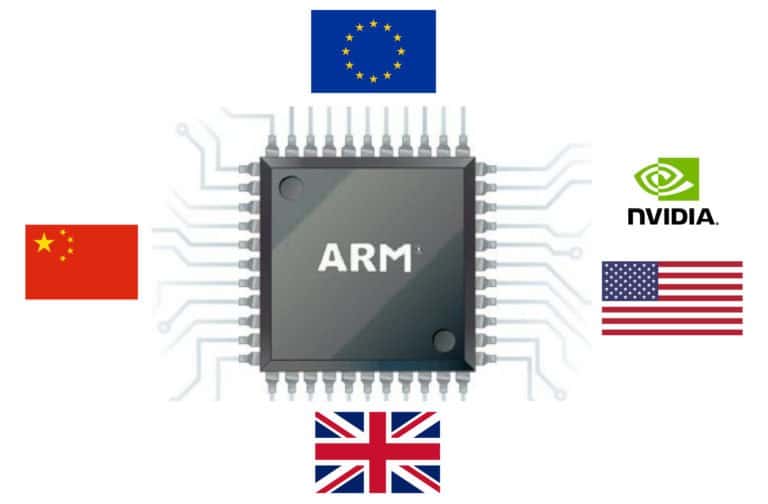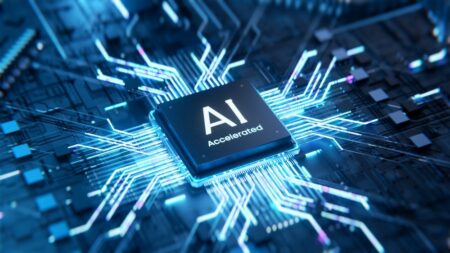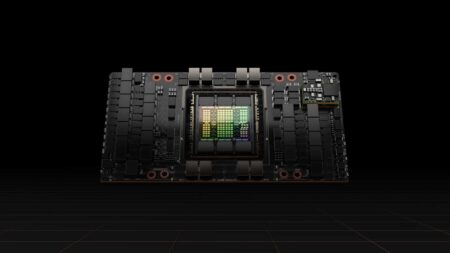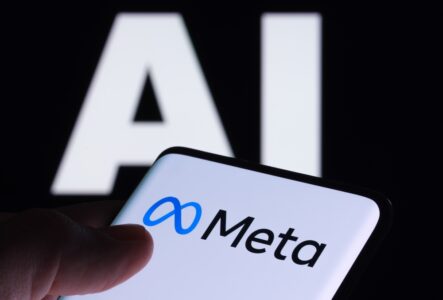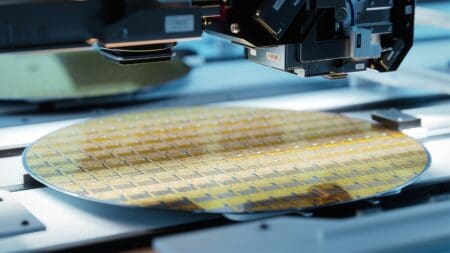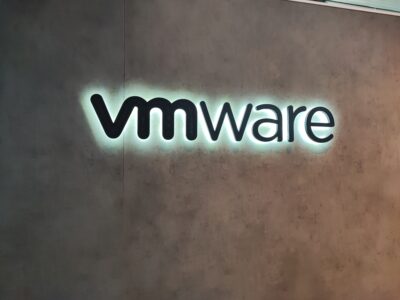Nvidia wants to acquire ARM from the Japanese Softbank. Both parties have agreed to the acquisition, and it is now up to the authorities to approve this takeover. Our opinion is that this takeover should be blocked. This is a bad plan for the semiconductor industry as well as for all countries that are not the United States.
Last week, Nvidia announced that it had reached an agreement with the Japanese Softbank for the acquisition of ARM. Nvidia will have to dig deep into its pockets for this acquisition, it needs to pay 40 billion dollars, partly in cash and the rest in Nvidia shares.
The company expects it will take 18 months to get the deal approved by the authorities. The big question now is whether it will be approved and if so, under which conditions. The United States, China, Europe, Japan and the United Kingdom all have to agree to the acquisition.
What does ARM do?
ARM (Acorn RISC Machine) is originally a British company, the headquarters of ARM is located in Cambridge. ARM already exists since the 80’s, but in the last 10 years, the company has grown exponentially. This growth is due to the rise of the mobile market. ARM designs chipsets that are both powerful and energy-efficient, making them ideal for smartphones and tablets.
ARM is not a well-known brand, but the designs of ARM form the basis of almost every mobile chipset. Companies like Apple, Huawei, Mediatek, Nvidia, Qualcomm and Samsung purchase licenses for chip designs from ARM. These companies then take the ARM designs and add some of their own technology and optimisations to these chipsets. They create chipsets for specific purposes and have them produced for particular goals, like the use in smartphones. The adjustments that the companies make to the chipsets vary enormously from brand to brand, but the fact remains that all mobile chipsets are based on ARM designs. Without these designs, they can’t make new chips. So ARM is a crucial player in today’s technology.
An acquisition like this can change the entire semiconductor industry. ARM doesn’t have many competitors, the biggest ones are probably Intel and AMD. Intel has developed chipsets for mobile devices in the past, but they were not very successful. AMD has ignored the mobile chipset market for now.
ARM is no longer independent under Nvidia.
For the semiconductor industry, this acquisition is not a good idea. It means that one of ARM’s customers will become the owner of the company and will therefore have a direct influence on ARM’s customer relationship with all of Nvidia’s competitors. Nvidia can claim that they will keep ARM independent and neutral, but usually, when these kinds of acquisitions happen, they often forget that promise after about three years. The possibility of thwarting competitors, by means of ARM’s licensing conditions or by increasing costs, can become very tempting in the long run.
The ARM designs are so-called System on a Chip designs, also called SoCs. A SoC has different modules; the most important ones are the CPU and GPU. ARM is incredibly strong on the CPU technology in combination with energy efficiency. The GPU part is something ARM does not excel at, and therefore manufacturers who buy a license for a chip design get the GPU part for free. It causes some manufacturers to try to develop a better GPU so they can differentiate themselves from the default chip design. Apple is doing that, and Samsung is currently working with AMD (Nvidia’s primary competitor) to develop a good ARM GPU. Nvidia is mighty in the GPU market, that is where the company’s roots lie. Nvidia wants to use ARM to sell its GPU technology to the ARM customers. With this, the GPU adventure of Samsung and AMD will probably end.
Ultimately, for the semiconductor market and mutual competition, it is not good if one of ARM’s customers also becomes the owner of the company. It encourages unfair competition.
Android and Apple are completely dependent on ARM
Android only supports ARM chips. This means that if Nvidia makes a mess of this acquisition, the entire Android ecosystem will be under pressure. Until version 4.2.1 Android still supported MIPS, a competitor of ARM, but there was too little interest for it. Since Intel discontinued its Android adventure, the x86 version of Android has also disappeared. Other competitors like RISC-V are not supported and that would be quite a challenge. However, Google will undoubtedly follow this situation closely and take action where necessary.
The same goes for Apple, iOS is completely focused on ARM, besides that Apple has announced it wants to quit Intel Macs and completely switch to ARM for the PC division (MacBooks iMacs) of the company. This would make Apple fully dependent on ARM. Freedom to combine ARM with AMD, for example, will probably no longer be possible.
ARM founder is against Nvidia
One of the founders of ARM has also spoken out, Herman Hauser is against the acquisition. He said that Nvidia cannot offer the neutrality that is so important at ARM. ARM only makes the designs, it does not compete with its customers in the production and sale of the chips, which Nvidia does. In addition, he believes that Nvidia will probably have little respect for the head office and R&D Center in Cambridge, which means many people could lose their jobs. He thinks that ARM would quickly disappear towards the United States. Something that brings us to the next point.
ARM should not fall into the hands of a U.S. company
Since President Trump is in power, it has become clear what happens when a president focuses on his own country and economy. Of course, it makes sense that Trump puts his own country in the first place, but Trump has introduced various trade bans against other countries in the world to protect the American economy. In some cases, this even means that U.S. technology becomes much more expensive or even unattainable. The latter is dangerous because, without U.S. technology, a country could go 20 to 30 years back in time.
In Europe, the Trump legislations have not caused any major problems at this moment, but after Trump, there can always be a president who is even more protectionistic and who will ban technology being sold to Europe. Europe could have a huge problem if this would occur because 95 percent of innovations and technology comes from the United States. In Europe, they accepted that every good professor, startup or new technology was bought by U.S. companies. Now there is so little technology left in Europe, that this could have a massive impact on our economy. The EU really needs to change its policies.
ARM is one of the vital technology companies, alongside with, for example, ASML. Both companies mean something in the global economy and ensures that Europe still has some technology that makes a difference. Although, technically ARM is no longer European because of the Brexit and it now has a Japanese owner. But it is also not American and that seems to be more important nowadays. Innovation and technology are increasingly important for the future, but it is not fairly distributed, because most of it comes from U.S. companies. Europe can still do something to improve their technology stack on the world stage. This would be the perfect time to act.
The EU, along with the British would have to come up 40 billion dollars to keep the company in Europe. If necessary, they could use a possible tax on U.S. tech companies for this purpose. Europe needs to focus much more on innovation and technology. From time to time there is talk about how new technologies should be financially supported, but Europe should not lose track of the gems that are already there. With ARM, an investment can be made that is also guaranteed to be successful. That remains to be seen in the case of new technologies.
The question is when will the European Commissioners wake up or who will alert them?
ARM is a master in the mobile market, but the PC and data center market is the next step.
For anyone who thinks that the mobile market is not important enough to invest 40 billion dollars of the taxpayers’ money. Apple wants to transfer its entire PC division to ARM, because those chips are now powerful enough to perform those tasks. This will undoubtedly mean that Windows computers cannot be left behind. Windows 10 can fully run on certain Qualcomm ARM chips.
Also, companies like Amazon and Huawei have already shown that they can develop ARM chips for data centers that can easily compete with Intel. There are also more and more ARM-based chips that run artificial intelligence (AI) at high speed and efficiency. A lot is expected from AI in the coming years in terms of innovation, ARM can play a crucial role in this. ARM will be at the basis of an enormous amount of technology in the future, in the United States they already have AMD and Intel. Europe could counter this with ARM.
Read also: Should Europe compete for technological world domination?
